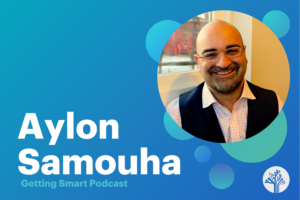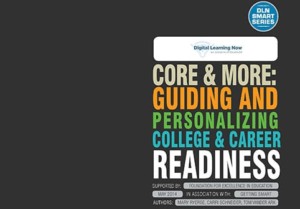When Preparing Kids for Their Future, Should We Lead with the Destination?
Key Points
-
We’re short-changing our students by introducing careers first; instead, we need to start with lifestyles.
-
To help students prepare for the kind of life they want to lead, we need to meet them where they are with bite-size digital content.

By: Nick Gross
Trying to build future readiness and prepare kids for the workforce is nothing new. Traditionally, educators have taken an approach that looks something like this:
- First, they present students with existing careers.
- Next, they narrow the focus by matching existing student strengths with current careers, and then building new strengths based on career choices.
- Finally, they point kids toward what else they’ll need to do to prepare for their chosen careers, and then hope their students will lead fulfilling lives based on their choices.
This is what I’d call the typical future readiness funnel, with exposure to existing careers at the top and students’ eventual discovery of the lifestyle particulars of those careers at the bottom. But does this approach work? Few employers believe students have what it takes for workplace success.
What’s the Problem?
Most students will switch jobs frequently and eventually need to consider jobs that aren’t currently on the table. So, if we are serious about preparing students for the fluidity of the career landscape and the future of work, we should focus first on who students want to become and how they want to live their lives, instead of zeroing in on what they think they want to be.
Here’s why this makes sense:
- Today’s careers may not exist by the time students are in the job market, while many new careers are projected to be options during their working lives.
- Existing student strengths factor in, but since employability skills can be taught, matching only existing strengths with only existing careers is shortsighted.
Why We Should Flip the Funnel
Our kids would be better prepared for the rapidly changing future if we switched things around and put them on the fluidity path to career readiness.
Here’s how educators can do that:
- First, help students identify their desired lifestyle. How do they want to live, regardless of which specific job they have?
- Next, help kids identify their existing strengths, while understanding that transferable skills can and should be taught, starting now.
- Finally, share a wide range of careers with kids that connect with their desired lifestyles.
If we start with lifestyle and end with particular careers, we position kids to experience more fulfillment with and connection to their work lives. Ultimately, it’s less about the job destination, since that could very well be a moving target, and more about their journey.
Why Starting with Lifestyle Makes Sense
Let’s see how this plays out with a student like Mia. In high school, Mia decides she wants to be a doctor. It sounds prestigious, her family encourages her, and she wants to make good money. Since Mia’s strong in science and a good student, this seems like a great plan to her teachers.
But after Mia takes out extensive student loans and spends many years in school, she discovers that being a doctor doesn’t align with how she envisioned her life. For starters, Mia wants to buy a home and can’t because she’s deeply in debt. She also feels stressed about the idea of being on the front lines when a serious health crisis hits.
If Mia had explored lifestyle options early on, she might have found out that being a medical researcher, physical therapist, or nutritionist would be preferable for her. Or she might have discovered that her goals around things like finances and work environment might point her in a different direction entirely.
Here are a few questions that may have helped Mia:
- What are your values?
- What kinds of places do you want to spend your time?
- Who do you want to spend your time with?
This upfront lifestyle exploration would have also helped Mia develop self-awareness, a pivotal social-emotional learning competency that employers often refer to as a highly desirable soft skill. And in this scenario, Mia could have saved significant time, money, and energy by first figuring out which jobs would and wouldn’t be a good fit with how she pictured her life.
How Kids Can Connect Desired Lifestyles with Associated Careers
Hearing directly from mentors who have the lifestyles students want empowers kids to go beyond just a general awareness of careers and really begin to have a personal, humanized connection to job possibilities. Mentors also build social-emotional (SEL) competency, as well as help kids develop career awareness that goes beyond salary and degree/training requirements. Ideally, mentors should represent not only traditional jobs, but also a wide range of new and emerging jobs, like social media influencer, data analyst, wind turbine engineer, and so on.
Where Strengths and Skills Fit In
It is never too soon for kids to start building strengths and developing 21st century life skills. What this looks like, in practical terms, is students beginning to recognize and engage in actions that will help them to achieve their current and future goals. It doesn’t work to just tell kids what sorts of skills they’ll need in the future; instead, we should give them the tools and guidance to begin building and practicing those skills today, in alignment with the type of lifestyle they want to lead and who they want to become.
How to Get Kids on a Personalized Fluidity Path
One key is how the career readiness content is delivered. Since Gen Z generally gets its information online in short, digestible bites (think TikTok), ideally they would also be able to prepare for their futures by exploring things in bite-size chunks. My EdTech company, Find Your Grind, lets kids develop their own personalized, self-paced fluidity path with an ESSA Tier-3 curriculum and familiar content types—things like short videos and the opportunity to earn badges that reinforce progress toward future readiness.
Whatever the learning platform, kids of all kinds of backgrounds, experiences, values, and strengths should be able to customize their career readiness path so they get content that’s specifically relevant to them and who they want to become. All students deserve to get the personalized path they need to get them where they want to go.
Nick Gross is the CEO of Find Your Grind.







0 Comments
Leave a Comment
Your email address will not be published. All fields are required.